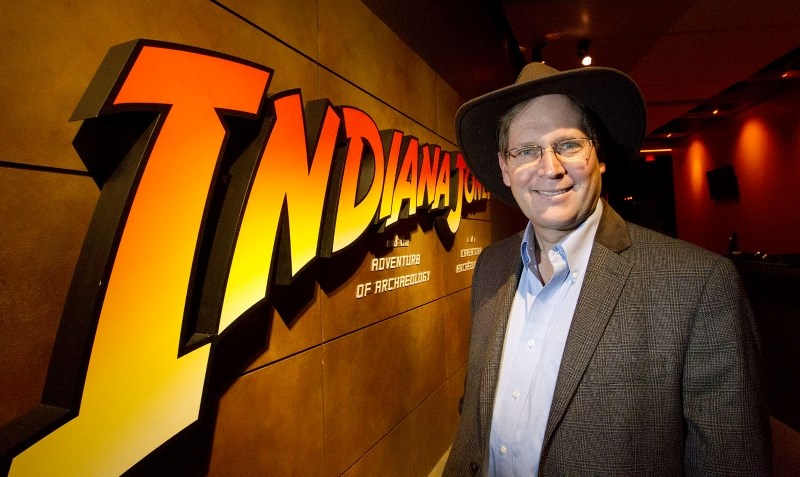Who else but Indiana Jones could bring both the Ark of the Covenant and the world's oldest map to Edmonton?
Well, Fredrik Hiebert, actually. The renowned archeologist with the National Geographic Society was in town this week to introduce a new Indiana Jones exhibit, and has just as many adventures under his fedora as his fictional counterpart.
He's explored ancient tombs, grappled with deadly curses, and earlier this year waded through waters infested with more poisonous snakes than Mr. Jones ever encountered.
"I don't have a bullwhip and I don't know what I'd do with it," he says, unless it was to whip his grad students into shape, but he does have quad-copters and technological tricks that would blow Indy's mind.
He's even got the hat.
He recalls how he was in Mongolia once and someone saw his hat and said, "That's an Indiana Jones hat!"
"I said, 'It's my hat!'"
Hiebert spoke to reporters Thursday about the new Indiana Jones and the Adventure of Archaeology exhibit opening today at the Telus World of Science in Edmonton. The travelling exhibit, which he helped create, features real props from the Indiana Jones films as well as about 100 actual archeological artifacts, many of them thousands of years old.
"These are 5,000-year-old golden treasures that decorated the tomb of Queen Puabi," he explains, pointing them out in one display. They include a gold-plated ostrich egg and solid-gold earrings the size of oranges, and were retrieved from the ancient Sumerian city of Ur.
"This is the world's oldest map," he continues, indicating a palm-sized chunk of pottery covered with lines and scrawls. It dates back to about 1,300 BC, and depicts the ancient city of Nippur in what is today known as Iraq.
"Those things that look like roads? Those are canals."
These are artifacts that you wouldn't normally see outside major museums in Britain or New York, Hiebert says.
This is an exhibit about science and culture with a pop-culture overlay, says Alan Nursall, president of the Telus World of Science – one that brings the centre back to its scientific roots.
"You could be eight or be 80 and have a fantastic time in this exhibit."
The real Indiana Joneses
The exhibit itself is saturated with so much character that you'd expect a giant boulder to come rolling at you at any moment. Visitors walk past towers of faux wooden crates labelled "Wehrmacht," "Top Secret," and "Property of Dr. Jones" down a dark passageway lit by eldritch hieroglyphics to confront the original Indiana Jones costume and the infamous golden idol from Raiders of the Lost Ark.
The Ark itself is just a few metres away. Even though it's a prop, Hiebert notes that film crews were still intimidated by its fictional face-melting powers.
"To this day, nobody has ever taken the top off of that prop."
As you follow the Indiana Jones trail past the otherworldly crystal skull and the Holy Grails (real and fake), side rooms direct you to examine real artifacts such as a 3,300-year-old piece of papyrus from the Egyptian Book of the Dead and the mysteries of the Nazca Lines – strange ancient geoglyphs in Peru so huge they can only be seen from an airplane.
Once rumoured to have been created by aliens, Hiebert says researchers have since learned that the Nasca Lines were likely religious symbols made by a local cult with a penchant for decapitation.
"I can promise you reality is much stranger than fiction."
Just as real archeologists inspired director George Lucas and the Indiana Jones series, Hiebert says the films inspired hordes of students to take an interest in the field.
"It was the best thing that ever happened in archeology," he says, and introduced the concept of the celebrity scientist.
"Is it historically accurate? No. Is it the best (scientific) practice? No. Is it a fun story? … Absolutely."
While real archeologists do deal with dangerous creatures, smugglers and ancient puzzles, St. Albert archeologist Merlin Rosser says the Indiana Jones films miss the most important part of archeology.
"Why does it 'belong in a museum'?" he says, paraphrasing one of Jones's catch-phrases.
"Because it belongs to the people."
Archeology is all about preserving the historical record for future generations, he explains.
"Which is why you never totally excavate a site," he notes – future generations will have better technology with which to understand what's there.
The exhibit opens Oct. 11 and runs until April. For details, as well as information on the accompanying lecture series, visit telusworldofscienceedmonton.ca.




